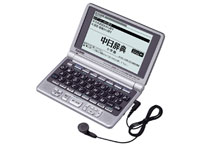|
|
|||||||
|
|
|||||||
|
|||||||
| | Web Japan >> | Trends in Japan >> | Business & Economy >> | Listen and Learn | |
|
LISTEN AND LEARN New Dictionaries Teach by Talking (June 26, 2006) Foreign-language dictionaries, whether paper or electronic, have long been seen and not heard. But that is changing quickly with the growing popularity of a slew of advanced "talking" electronic dictionaries. With these devices, a recorded voice reads out words or expressions after they are looked up. The voices are those of native speakers, which is greatly appreciated by Japan's foreign-language students, who are increasingly keen to sharpen their listening skills. Sales Talk Of the 18 electronic dictionaries released in the spring of 2006 by Casio Computer Co., the largest manufacturer of electronic dictionaries, 15 can "speak" in the voices of native speakers. Previously, no more than half of Casio's electronic dictionaries were of the speaking variety. All Ears Another factor is the current boom in Japan for Chinese-language study. Many students of Chinese, bedeviled by the language's difficult pronunciation and tonal system, are keen to have a device that speaks out words and expressions in the voice of a native speaker. A dictionary made by Canon Inc. that went on sale in April 2006 features voices screened for accuracy by a training school for TV presenters in China. When the students use the record function, they can compare their own pronunciation with that of the native speakers. As electronic dictionaries pack in more and more features, they are increasingly finding favor not just among young people but older generations as well. Now that the market for electronic dictionaries has reportedly grown in size to more than double that for book dictionaries, the question on the minds of many prospective buyers is not, "How many words does it contain?" but rather, "How many can it speak?" Copyright (c) 2006 Web Japan. Edited by Japan Echo Inc. based on domestic Japanese news sources. Articles presented here are offered for reference purposes and do not necessarily represent the policy or views of the Japanese Government. |
||
|




